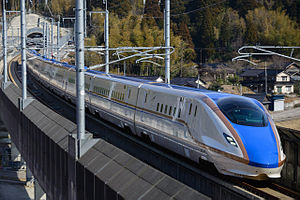W7 series
| W7 series | |
|---|---|

Set W3 on a public preview run, February 2015
|
|
| Manufacturer | Hitachi, Kawasaki Heavy Industries, Kinki Sharyo |
| Constructed | 2014–2015 |
| Entered service | 14 March 2015 |
| Number built | 132 vehicles (11 sets) |
| Number in service | 132 vehicles (11 sets) |
| Formation | 12 cars per set |
| Fleet numbers | W1–W11 |
| Capacity | 934 |
| Operator(s) | JR-West |
| Depot(s) | Hakusan |
| Line(s) served | Hokuriku Shinkansen |
| Specifications | |
| Car body construction | Aluminium alloy |
| Car length | 26,000 mm (85 ft 4 in) (end cars) 25,000 mm (82 ft 0 in) (intermediate cars) |
| Width | 3,380 mm (11 ft 1 in) |
| Doors | 2 sliding doors per side |
| Maximum speed | Design: 275 km/h (170 mph) Service: 260 km/h (160 mph) |
| Weight | approx. 540 t |
| Power output | 12 MW |
| Acceleration | 1.6 km/h/s |
| Electric system(s) | 25 kV AC, 50/60 Hz |
| Current collection method | Overhead catenary |
| Safety system(s) | DS-ATC, RS-ATC |
| Track gauge | 1,435 mm (4 ft 8 1⁄2 in) |
The W7 series (W7系 Daburu-nana-kei?) is a Japanese Shinkansen high-speed train type operated by West Japan Railway Company (JR-West) on the Hokuriku Shinkansen since it was extended from Nagano to Kanazawa in March 2015. Jointly developed alongside the similar JR East E7 series, a total of eleven 12-car W7 series sets (132 vehicles) have been built. The first W7 series train was delivered in April 2014.
Based on the earlier E2 series trains, the W7 series trains were designed with a "Japanese" theme inside and out, combining futuristic styling with traditional design elements overseen by industrial designer Ken Okuyama together with Kawasaki Heavy Industries. Externally, the roof is finished in a "sky blue" colour, and the bodysides are "ivory white" with "copper" and "sky blue" lining. The bodyside logos consist of a number "7" in silver stylized as an arrowhead, and include the lettering "West Japan Railway Company".
Bodyside logo on car 11
Manufacture of the W7 series sets was shared between Hitachi in Kudamatsu, Yamaguchi, Kawasaki Heavy Industries in Kobe, and Kinki Sharyo in Osaka.
The trains have a maximum design speed of 275 km/h (170 mph), but in service operate at a maximum speed of 260 km/h (160 mph) on the Hokuriku Shinkansen, limited to 240 km/h (150 mph) on the Joetsu Shinkansen tracks between Omiya and Takasaki, and to 110 km/h (70 mph) on the Tohoku Shinkansen tracks between Tokyo and Omiya. Increased power output enables the trains to maintain speeds of at least 210 km/h (130 mph) on the steep gradients of the Hokuriku Shinkansen.
...
Wikipedia
